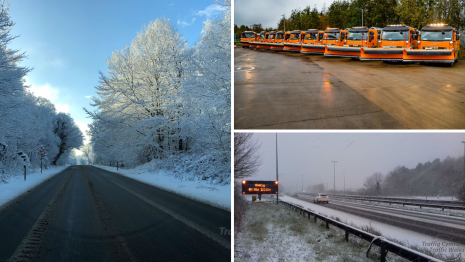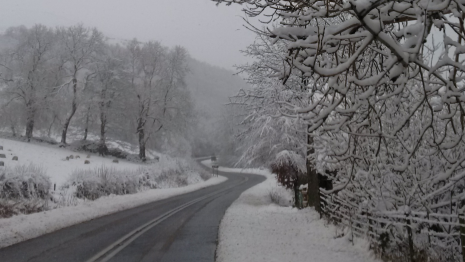Each year, we operate our winter service from 1 October to the end of April. Our activities are designed to help you continue on your journey safely.
At the start of each winter we replenish the salt stored in our barns. We use this to treat approximately 1900 kilometres of salting routes in Wales. On average, typically 87 nights of spreading salt are carried out during the 212 day winter season.
To help keep motorists on the move, we have 171* gritters based at 39 depots strategically located across the network. *A number of which cover the strategic road network. the gritters in North and Mid Wales work on the county and trunk routes.
What we do during winter
Our staff in the Traffic Management centre operate 24 hours a day. They use road cameras, traffic flow data and road weather forecasts to identify the best time to carry out winter maintenance.
They working closely with our Traffic Officers, maintenance partners and the emergency services. They use all this information to decide which areas will be gritted, reduce speed limits and set overhead signs to warn motorists of severe weather and road conditions.
What you can do during winter
When the weather is extreme, ask yourself:
- Do I really need to travel now or can my journey wait until the weather improves?
- Should I plan an alternative route?
- Have I checked my route for delays and poor weather conditions?
- Is my car ready for the journey?
- Have I packed an emergency kit?
- Will I need to change my driving style to suit the conditions?
Be prepared – check your vehicle is ready for difficult conditions.
Be informed – check the latest traffic and weather before you go.
Breaking down is never a pleasant experience – even less so in cold and wintry weather. Keeping your vehicle well-maintained to handle difficult driving conditions will help you and others stay safe on the road.
- Have your vehicle serviced and anti-freeze tested before winter starts.
- Make sure your battery is in good condition and fully charged.
- Check all tyres for condition, correct pressure and tread depth.
- Check your wipers, lights and indicators are clean and working.
- Keep the windscreen and windows clean, and the washer bottle filled with screenwash at the correct concentration to prevent the solution freezing.
- Use air conditioning for faster demisting and to reduce condensation on cold windscreen/windows.
Pack these items in your vehicle at the start of winter - you never know when you might need them.
- Ice scraper and de-icer
- Torch and spare batteries, or a wind-up torch
- Warm clothes and blankets, for you and all passengers
- Sunglasses (the low winter sun and glare off snow can be dazzling)
- Jump leads
- Shovel
- Road atlas
- Boots
- First aid kit
If you wake up to severe weather, or difficult conditions are forecast, ask yourself: do I really need to travel now or can my journey wait until the weather improves? Could I work from home? Is the school closed? Can the appointment be moved?
If your journey is essential, think about the safest way to travel. It's not advisable to drive when conditions deteriorate unless absolutely necessary. Allow extra time for your journey and if possible, tell someone at your destination when you expect to arrive.
Check the local weather forecast and traffic conditions. Do you need to plan an alternative route?
Traffic Wales provides traffic information and CCTV camera images for Wales’ motorway and trunk road network on this website, on Twitter and Facebook @TrafficWalesS for South Wales, @TrafficWalesN for North and Mid Wales. For local authority roads, listen to local radio.
Make sure you are fully equipped with your emergency kit, food, a warm drink in a flask and any medication you or passengers need to take regularly. Check you have enough fuel and you know where to fill up.
Make sure you can see clearly and that you can be seen: clear lights, windows, mirrors and number plates. Remove all snow from your vehicle, including the roof and bonnet, as it can hit other road users.
On Wales’ motorways and trunk roads, the South Wales and North and Mid Wales Trunk Road Agents work to prevent ice forming and remove any snow and ice from the carriageway. Local authorities look after all the other roads. Both work as hard as they can to keep their networks clear during severe weather, but not every road can be treated and you need to take extra care on minor roads.
Even if the time and location of snowfall is perfectly forecast, it will still take time to clear the snow after it has fallen and to treat the road with salt to reduce the risk of ice. It's not just the salt treatment that helps cut through snow and ice, it's the steady flow of traffic too.
Remember though, snow ploughs can't get through if the road or motorway is full of stationary traffic, so give the teams the space they need to do their job and help you on your journey. Keep a safe distance behind winter maintenance vehicles.
When you're on the road, pay attention to the changing road, traffic and weather conditions. Be ready to slow down and take more care if you need to, particularly on bends and exposed roads. Don't be lulled into a false sense of security - even if you drive every day on the same stretch of road.
Drive at a speed suitable to the conditions, stick to the highest possible gear to avoid wheel spins and take care when braking (getting into a low gear first). Stopping a vehicle in icy, slushy conditions can take ten times longer than on a dry road.
It's not only snow that affects journeys during the winter period. You should also be mindful of:
- Low sun: be prepared by having ready access to sunglasses and by ensuring your windscreen is clean inside and out.
- Floods and standing water: avoid it if you can - do you know how deep it is? Check your brakes are working once you're through if you've had to drive through water.
- Fog: Drive at a speed that allows you to stop in the distance you can see clearly. Use your headlights and fog lights correctly to ensure you don't dazzle other drivers. Fog can be patchy - don't speed up suddenly, even if it seems to be clearing. You can suddenly find yourself back in thick fog. Avoid hanging on to the tail-lights of the vehicle in front - you may be driving too close.
During your journey remember this critical question:
- If I had to brake suddenly in an emergency, could I stop safely within the distance I can clearly see ahead of me?
Further advice on driving in adverse weather conditions is available in the Highway Code.
On major routes, important travel messages will be displayed on roadside message signs, including warning you of delays and advising of alternative routes.
Listening to local radio will also help you keep up-to-date with the latest travel and weather information.
On long journeys, consider taking a break at regular intervals - and that's an ideal time to check the traffic conditions on the road ahead.
While you are safely parked, check the latest information via your mobile phone, smartphone or laptop. Never stop on the hard shoulder to do this and never use your mobile phone while driving.
Download Traffic Wales Traffig Cymru for iPhone and Android.
Follow us on Twitter and Facebook @TrafficWalesS for South Wales and @TrafficWalesN for North and Mid Wales.


